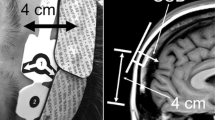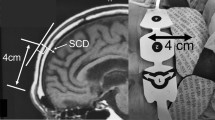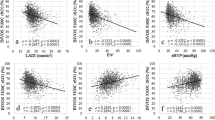Abstract
Regional cerebral oximetry using near-infrared spectroscopy device, an INVOS 5100 C (Medtronic, Minneapolis, MN, USA), during cardiac surgery aims to avoid perioperative neurological impairment, especially during cardiopulmonary bypass. However, it is not uncommon to encounter critically low initial cerebral regional oxygen saturation or a low value unresponsive to intervention. Therefore, it is important to identify factors associated with low saturation value other than true cerebral hypoxia. We investigated the relationship between preoperative regional cerebral oxygen saturation and clinical variables during cardiac surgery. From January 2013 to May 2016, 462 patients underwent elective cardiac surgery. Patient’s ≤12 years of age, with acute cerebral infarction, with previous intracranial hemorrhage or neurosurgery, with concomitant aortic surgery, and having off-pump coronary artery bypass surgery were excluded. The remaining 223 patients were monitored by intraoperative regional cerebral oximetry. Univariate analysis found that scalp-cortex distance, cerebrospinal fluid thickness, left ventricular ejection fraction, hemoglobin concentration, estimated glomerular filtration rate, and hemodialysis were significantly correlated with the initial regional oxygen saturation value. Multiple regression analysis revealed that scalp-cortex distance, left ventricular ejection fraction, hemoglobin, and hemodialysis remained as significant variables. A receiver operating characteristic analysis found that for a low initial regional oxygen saturation value of 40%, the thresholds of scalp-cortex distance, left ventricular ejection fraction, and hemoglobin concentration were 17.6 mm, 45.2%, and 7.5 g/dl, respectively. In conclusion, brain atrophy, poor left ventricular function, anemia, and hemodialysis were associated with low initial cerebral regional oxygen saturation values in adult cardiac surgery patients.



Similar content being viewed by others
References
Roach GW, Kanchuger M, Mangano CM, Newman M, Nussmeier N, Wolman R, Aggarwal A, Marschall K, Graham SH, Ley C, Ozanne G, Mangano DT. Adverse cerebral outcomes after coronary bypass surgery. N Engl J Med. 1996;335:1857–63.
Edmonds HL Jr. Pro: all cardiac surgical patients should have intraoperative cerebral oxygenation monitoring. J Cardiothorac Vasc Anesth. 2006;20:445–9.
Bruggemans EF. Cognitive dysfunction after cardiac surgery: pathophysiological mechanisms and preventive strategies. Neth Heart J. 2013;21:70–3.
Slater JP, Guarino T, Stack J, Vinod K, Bustami RT, Brown JM 3rd, Rodriguez AL, Magovern CJ, Zaubler T, Freundlich K, Parr GV. Cerebral oxygen desaturation predicts cognitive decline and longer hospital stay after cardiac surgery. Ann Thorac Surg. 2009;87:36–45.
Yao FS, Tseng CC, Ho CY, Levin SK, Illner P. Cerebral oxygen desaturation is associated with early postoperative neuropsychological dysfunction in patients undergoing cardiac surgery. J Cardiothorac Vasc Anesth. 2004;18:552–8.
Colak Z, Borojevic M, Bogovic A, Ivancan V, Biocina B, Majeric-Kogler V. Influence of intraoperative cerebral oximetry monitoring on neurocognitive function after coronary artery bypass surgery: a randomized, prospective study. Eur J Cardiothorac Surg. 2015;47:447–54.
Murkin JM, Adams SJ, Novick RJ, Quantz M, Bainbridge D, Iglesias I, Cleland A, Schaefer B, Irwin B, Fox S. Monitoring brain oxygen saturation during coronary bypass surgery: a randomized, prospective study. Anesth Analg. 2007;104:51–8.
Denault A, Deschamps A, Murkin JM. A proposed algorithm for the intraoperative use of cerebral near-infrated spectroscopy. Semin Cardiothorac Vasc Anesth. 2007;11:274–81.
Zheng F, Sheinberg R, Yee MS, Ono M, Zheng Y, Hogue CW. Cerebral near-infrared spectroscopy (NIRS) monitoring and neurologic outcomes in adult cardiac surgery patients and neurologic outcomes: a systematic review. Anesth Analg. 2013;116:663–76.
Gottlieb EA, Fraser CD Jr, Andropoulos DB, Diaz LK. Bilateral monitoring of cerebral oxygen saturation results in recognition of aortic cannula malposition during pediatric congenital heart surgery. Paediatr Anaesth. 2006;16:787–9.
Chan SK, Underwood MJ, Ho AM, So JM, Ho AK, Wan IY, Wong RH. Cannula malposition during antegrade cerebral perfusion for aortic surgery: role of cerebral oximetry. Can J Anaesth. 2014;61:736–40.
Gregory AJ, Hatem MA, Yee K, Grocott HP. Optimal placement of cerebral oximeter monitors to avoid the frontal sinus as determined by computed tomography. J Cardiothorac Vasc Anesth. 2016;30:127–33.
Jöbsis FF. Noninvasive, infrared monitoring of cerebral and myocardial oxygen sufficiency and circulatory parameters. Science. 1977;198:1264–7.
Ferrari M, Giannini I, Sideri G, Zanette E. Continuous non invasive monitoring of human brain by near infrared spectroscopy. Adv Exp Med Biol. 1985;191:873–82.
Heringlake M, Garbers C, Käbler JH, Anderson I, Heinze H, Schön J, Berger KU, Dibbelt L, Sievers HH, Hanke T. Preoperative cerebral oxygen saturation and clinical outcomes in cardiac surgery. Anesthesiology. 2011;114:58–69.
Goldman S, Sutter F, Ferdinand F, Trace C. Optimizing intraoperative cerebral oxygen delivery using noninvasive cerebral oximetry decreases the incidence of stroke for cardiac surgical patients. Heart Surg Forum. 2004;7:E376–E81.
Bickler PE, Feiner JR, Rollins MD. Factors affecting the performance of 5 cerebral oximeters during hypoxia in healthy volunteers. Anesth Analg. 2013;117:813–23.
Moerman A, Vanden;las G, Bové T, Wouters PF, De Hert SG. Relation between mixed venous oxygen saturation and cerebral oxygen saturation measured by absolute and relative near-infrared spectroscopy during off-pump coronary artery bypass grafting. Br J Anaesth. 2013;110:258–65.
Van Beekvelt MC, Borghuis MS, Van Engelen BG, Wevers RA, Colier WN. Adipose tissue thickness affects in vivo quantitative near-IR spectroscopy in human skeletal muscle. Clin Sci (Lond). 2001;101:21–8.
Oliveira MF, Zelt JT, Jones JH, Hirai DM, O’Donnell DE, Verges S, Neder JA. Does impaired O2 delivery during exercise accentuate central and peripheral fatigue in patients with coexistent COPD-CHF? Front Physiol 2015; doi:10.3389/fphys.2014.00514.
Yoshitani K, Kawaguchi M, Okuno T, Kanoda T, Ohnishi Y, Kuro M, Nishizawa M. Measurements of optical pathlength using phase-resolved spectroscopy in patients undergoing cardiopulmonary bypass. Anesth Analg. 2007;104:341–6.
Jiang XL, Wen JQ, Zhang LJ, Zheng G, Li X, Zhang Z, Liu Y, Zheng LJ, Wu L, Chen HJ, Kong X, Luo S, Lu GM, Ji XM, Zhang ZJ. Cerebral blood flow changes in hemodialysis and peritoneal dialysis patients: an arterial-spin labeling MR imaging. Metab Brain Dis. 2016;31:929–36.
Thalhammer C, Clemens RK, Valentin ML, Alonso E, Segerer S, Husmann M, Amann-Vesti BR. Vertebral and internal mammary artery steal syndrome in patients with hemodialysis access. Vasa. 2016;45:163–8.
Maiodna E, Ambekar S, Johnson JN, Elhammady MS. Dialysis arteriovenous fistula causing subclavian steal syndrome in the absence of subclavian artery stenosis. Case Rep Vasc Med 2015; doi:10.1155/2015/720684.
Eicke BM, Berwig C, Wigger W, Paulus W. Volumetric measurements of the brachial and carotid arteries in dialysis grafts: is there evidence of a subclavian-carotid artery steal syndrome? J Ultrasound Med. 1998;17:759–63.
Young AE, Germon TJ, Barnett NJ, Manara AR, Nelson RJ. Behaviour of near-infrared light in the adult human head: implications for clinical near-infrared spectroscopy. Br J Anaesth. 2000;84:38–42.
Yoshitani K, Kawaguchi M, Miura N, Okuno T, Kanoda T, Ohnishi Y, Kuro M. Effects of hemoglobin concentration, skull thickness, and the area of the cerebrospinal fluid layer on near-infrared spectroscopy measurements. Anesthesiology. 2007;106:458–62.
Okada E, Delpy DT. Near-infrared light propagation in an adult head model. II. Effect of superficial tissue thickness on the sensitivity of the near-infrared spectroscopy signal. Appl Opt. 2003;42:2915–22.
Haldenwang PL, Strauch JT, Amann I, Klein T, Sterner-Kock A, Christ H, Wahlers T. Impact of pump flow rate during selective cerebral perfusion on cerebral hemodynamics and metabolism. Ann Thorac Surg. 2010;90:1975–84.
Haldenwang PL, Strauch JT, Mullem K, Reiter H, Liakopoulos O, Fischer JH, Christ H, Wahlers T. Effect of pressure management during hypothermic selective cerebral perfusion on cerebral hemodynamics and metabolism in pigs. J Thorac Cardiovasc Surg. 2010;139:1623–31.
Author information
Authors and Affiliations
Corresponding author
Ethics declarations
Conflict of interest
The authors have no conflicts of interest to declare.
Rights and permissions
About this article
Cite this article
Kobayashi, K., Kitamura, T., Kohira, S. et al. Factors associated with a low initial cerebral oxygen saturation value in patients undergoing cardiac surgery. J Artif Organs 20, 110–116 (2017). https://doi.org/10.1007/s10047-016-0941-6
Received:
Accepted:
Published:
Issue Date:
DOI: https://doi.org/10.1007/s10047-016-0941-6




